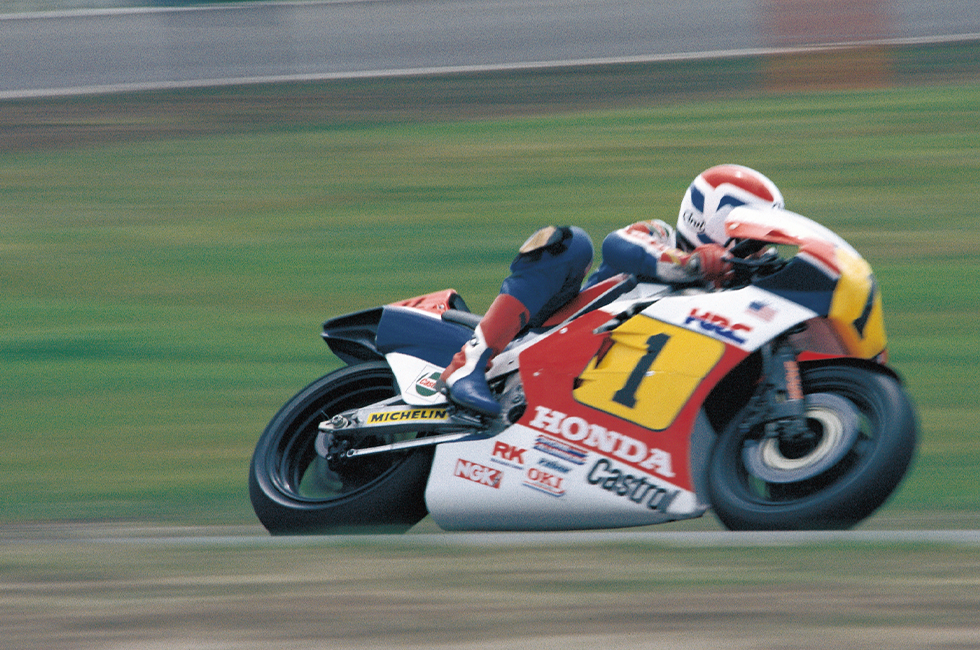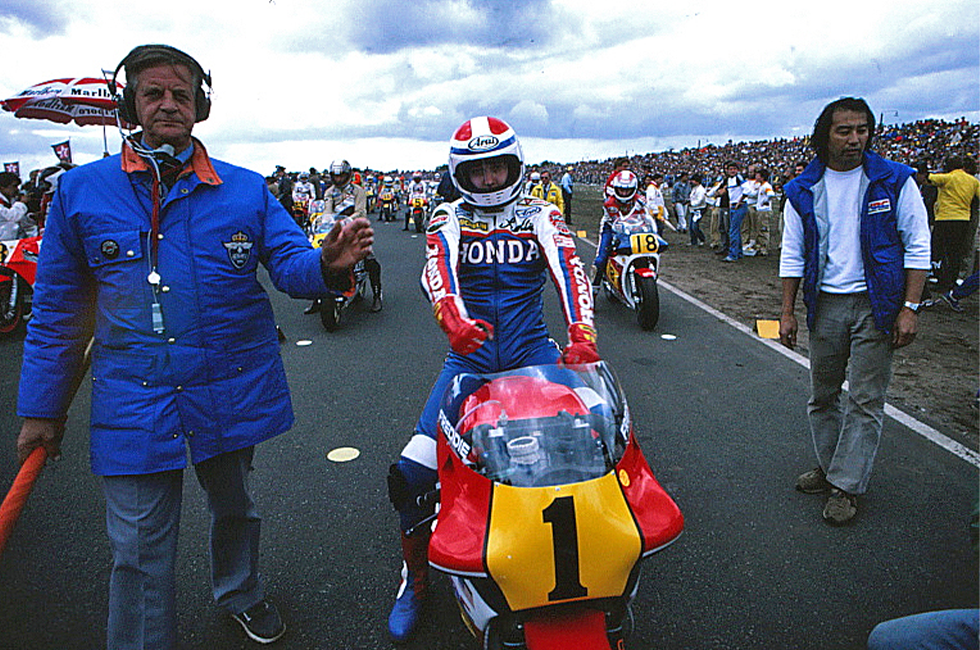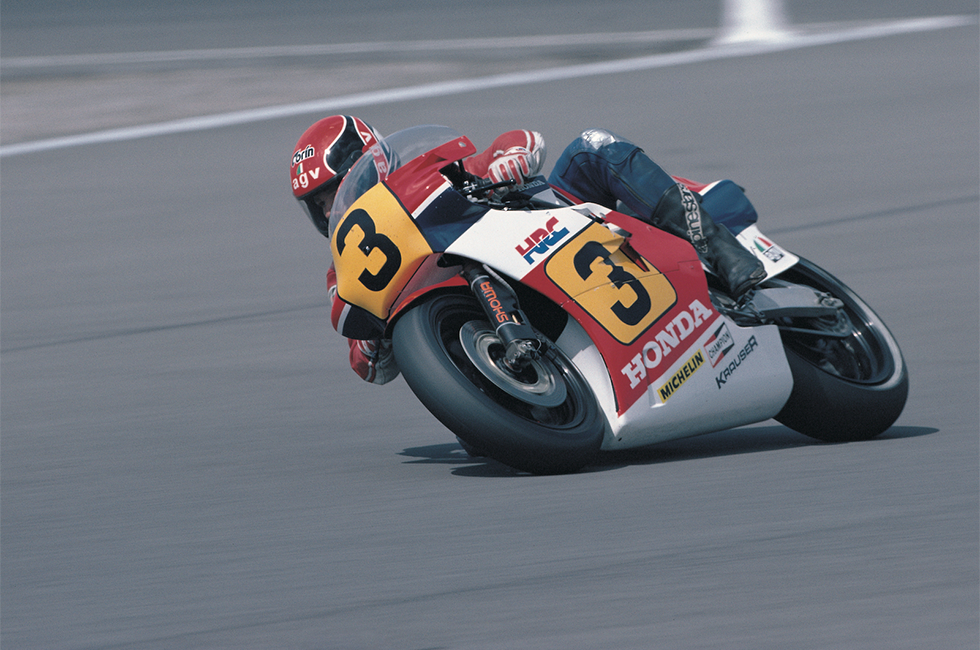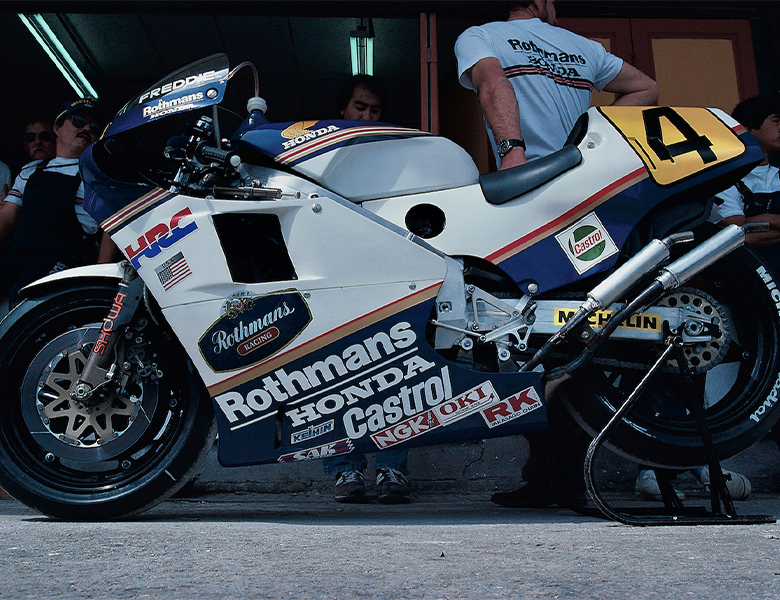The first-generation NSR500 [NV0A] was a unique racer featuring an upside-down body layout, such as a fuel tank under the engine. Although it was one of the fastest machines in the 1984 FIM Road Racing World Championship, it seemed immature in some areas. HRC then needed more capacity to improve the challenging upside-down layout. Therefore, they designed the second NSR500 [NV0B] model straightforwardly, giving Freddie Spencer the overwhelming strength to win the championship in 1985.
The NV0A became an unprecedented machine remembered as demonstrating Honda's originality.

1984 NSR500 [NV0A] + Freddie Spencer at the eighth round, Dutch TT (Photo/Jiro Ishida)
Spencer's overwhelming victory in the West German GP on the NS500 reaffirmed the competitive power of this 3-cylinder engine. In the next two races, he returned to the NV0A and showed off its actual speed. By riding the machine with an upside-down layout, Spencer took pole position and solo victory in both races. Paul Ricard, where the French GP was held that year, and Rijeka, the venue for the Yugoslavian GP, both had long straight sections and were not at high altitudes, making them circuits that showed off the best of the NV0A.
HRC has accomplished its mission of winning with its favorite machine, the NSR500, in three of the seven World Grand Prix races. However, the NV0A's performance in the eighth round, Dutch TT (Dutch GP), could have been better. No matter how they changed the settings, the machine that had won two consecutive previous races could not achieve good handling and output characteristics. Even with Spencer, qualifying 5th was the best he could do. Moreover, one of his plug caps fell off plug cap fell off in the final race, forcing him to retire early.

Spencer sat on the Dutch TT's second row of the starting grid. On the right of the photo is his crew chief, Erv Kanemoto. (Photo/Jiro Ishida)
Due to the layout, the NV0A used a very short spark plug of 49.6mm and a special plug cap that ensured sufficient connectivity even with a terminal much shorter than a regular machine. However, the problem of coming off occurred only at this Dutch TT.
The next race was the ninth round, the Belgian GP at Spa-Francorchamps. In qualifying, Spencer rode while switching between NV0A and NS500, setting the fastest time on the 3-cylinder machine. He also used the NS500 in the final race and won an overwhelming victory. In other words, it was another race where the NV0A lost.
The best time Spencer recorded in qualifying on the NV0A was 0.85 seconds faster than the personal best of Eddie Lawson, who also rode a V4-engined Yamaha YZR500. However, performance was unstable. The engine was a particular problem, with a comment in the HRC report saying, "Even if you adjust the main jet, you will only get a certain amount of results."
Spencer was at Laguna Seca in the USA the week after the Belgian GP. Although it was an AMA National Championship race, Spencer also rode the NV0A in a particular race where several big-name American riders participated, including Kenny Roberts, who retired from the World Grand Prix the previous year. However, Spencer fell during the qualifying session and broke his collarbone, which ended his 1984 season.
After all, Spencer only ran the finals of seven WGP races in 1984. Although he only rode the NV0A in five races, he won three. In addition, at the tenth round, the British GP, held after Spencer was sidelined due to a broken collarbone, Randy Mamola ran the final race on an NV0A, winning a close battle with Yamaha's Lawson. The first-generation NSR500 won a total of four WGP races.
However, HRC did not adopt an upside-down layout for the following season's machine. That policy was already solidified early in the 1984 season. The racing machine that earned the title NSR was not a research vehicle but a motorcycle designed to win races.

For the first half of the 1984 season, Randy Mamola competed on a 3-cylinder NS500, but after the sixth round, the French GP was also offered the NV0A. Then, at the British GP, which was held at the ultra-high-speed Silverstone circuit, Mamola selected the NV0A for the final race for the first time. He defeated Yamaha's Lawson to score the last victory for an upside-down layout machine. (Photo/Shigeo Kibiki)
While continuing to evolve, the NSR500 competed in the premier road racing class for 19 years, reigning as the most vital machine. Among them, the technical specifications of the first model, NV0A, were quite exceptional. Possibilities may have opened up if they continued to pursue the advantages of a racer body configuration in which the fuel tank was placed below the engine. However, at the time, HRC did not have the luxury of pursuing to pursue such research and development.
As a result, the NV0A became an unprecedented upside-down layout machine. However, it is precisely for this reason that it has become a machine that has been talked about for many generations by many fans as a demonstration of Honda's originality.






